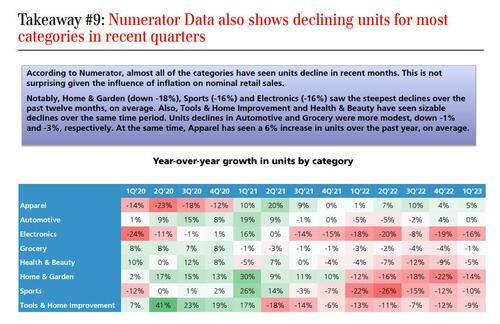
Over 2,000 stores across all retail sectors have closed in the past 12 months according to a recent report from UBS retail analyst Michael Lasser (available to pro subs in the usual place), and that is just the beginning. “As of 3Q’22 (latest available data), retailers shed -1,500 net stores. This number is already up significantly in ’23 with the likes of Bed Bath & Beyond, Foot Locker, Tuesday Morning and others closing stores recently” the UBS economists wrote.
“We believe this trend should continue in the years to come, with consumers consolidating their trips and shifting towards online channels. As underperforming retail stores are shuttered, it should help the store productivity of surviving locations,” the report authors said, and predicted that over the next 5 years, “another 50,000 stores will close on the current store base of ~940K stores in the US (ex. gas and food service).”
“This simply implies that there will be -5% fewer stores by the end of ’27. As this happens, we believe this trend will benefit the large, well-capitalized retailers HD, LOW, WMT, TGT, COST) and those with unique differentiations (FND, ASO, EYE) who stand to capture a disproportionate amount of market share.” In other words, just like with US banks, the big players will only get bigger while the small ones disappear.
To put this in perspective, UBS calculates that assuming 50k stores close over the next five years and that the average sales per store is $5.7mm, it would translate to $285b of retail sales that are “up for grabs”. Assuming that 26% of these sales go online (the bank’s ’27 estimate for penetration), it would mean that retailers like WMT, HD and COST have the potential to attract $210b in sales. This translates to $1,600 annual spend per household that has the potential to shift to the leading retailers.
The good news for big retailers is bad news for the small ones:
In our view, these smaller chains and mom & pops are most at risk of closures given these firms typically have less access to capital needed to invest in developing a robust omni-channel offering. As of 2020, 57% of retail stores are operated by firms with less than 20 employees and 68% of stores are operated by chains with less than 500 employees. These smaller chains shed -40K stores in the past 10 years while chains with 500+ employees added 17K stores.
It could get even worse: the base case scenario assumes that retail sales growth continues at 4% annually which is inline with the long-term trend. However, in a downside case, the protracted US recession would put downward pressure on the UBS store closure forecast where if retail sales only grow 3.0-3.5% it would result in 70K-90K closures
UBS highlighted several factors that are driving retail store closures. They include higher costs, which raise the bar for keeping stores open; a decline in units per store in most retail sectors; and the likelihood that store closures will disproportionately affect smaller chains.
From 2007 to 2019, firms with less than 500 employees closed about 40,000 stores, or 5% of their base, while retailers with more than 500 employees added 17,000 stores. The overall cost of doing business rose significantly in the last 12 months, due in part to higher wages. Retail hourly wages, which are typically the largest cost component of running a store, increased about 5% over the last years, the analysts said.
On top of that, retailers will need to increase store productivity by 4.5% annually as retail rents per square foot increase for neighborhood and community centers. “These costs will likely continue to move higher, increasing the hurdle rate to keep stores open,” UBS said.
As RetailDive notes, about 14,000 of the estimated closings will be in the softlines sector. UBS forecasts that department stores and specialty retailers will remain net store closers. And while retailers with a heavy mall presence will continue store closings, there is a faint silver lining for off-price retailers who should grow units.
The report also singles out consumer electronics and home furnishings as retail sectors that also need to shrink their store footprint. Consumer electronics retailers should close about 9,000 stores, while home furniture stores should shrink by about 4,000 locations.
One change that’s become essential versus discretionary for retailers is an increasing embrace of digital investments like buy online, pay in store; ship from store; same-day delivery; and buy online, return in store. UBS says online retail spending per household was $9,900 in 2022, up from $8,900 a year ago and up from $4,000 in 2015. Companies with a strong DTC focus combined with high brand loyalty, like Nike and Levi’s, are best positioned for the ongoing shift to digital fulfillment.
Finally, while there is much more in the full report, here are the 9 main takeaways:
Takeaway #1: We estimate 50K+ stores will close by ’27 if online penetration goes to 26% & retail sales grow 4%Takeaway #2: Store closures will vary by subsectorTakeaway #3: In 2022, there were net store closings, a reversal from strong store openings in 2021Takeaway #4: We assume 4% retail sales growth until 2027, in-line with its long-term averageTakeaway #5: A step change in banks willingness to lend tends to be a leading indicator of an acceleration in store closuresTakeaway #6: Higher costs raises the hurdle rate on keeping stores openTakeaway #7: Store closures will likely impact smaller chains disproportionatelyTakeaway #8: Several sectors are at or near peak store productivityTakeaway #9: Units per store declined for most sub-sectors in 2022 (trends vary by sub-sector)
Much more in the full report and slideshows available to pro subs in the usual place.
Loading…



